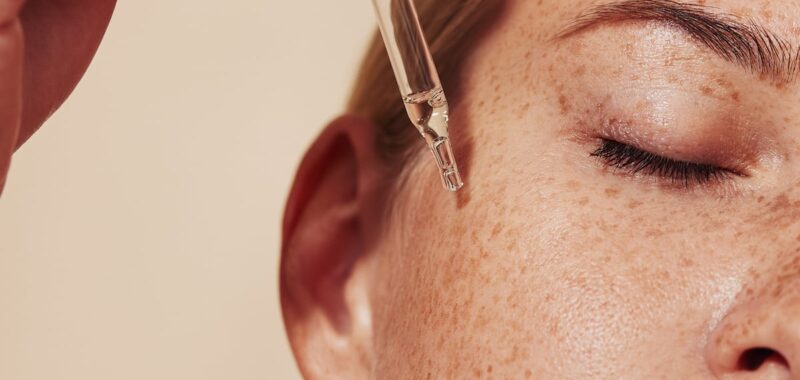
As the beauty industry continues to evolve toward better meeting consumer needs, preferences are shifting toward science-backed ingredients, streamlined routines, and sustainable solutions. With skin care literacy on the rise, brands are adapting their strategies to meet the demand for transparency, efficacy, and multi-functional products.
From ingredient innovation to evolving pricing strategies, manufacturers are finding new ways to engage an increasingly informed audience.
We spoke to Melissa Munnerlyn, Co-Founder & CMO of Daash Intelligence, for her insights into the data behind the rising popularity of hyaluronic acid and other active ingredients in skin and body care products.
Ingredient insights: Hyaluronic acid and rising actives
“Year to date, products with ‘hyaluronic acid’ in their names represent 9% of total prestige beauty sales and 12% of total units sold across categories including makeup, skin care, fragrance, hair, and bath & body,” Munnerlyn told CosmeticsDesign. In the skin care and makeup segments specifically, she elucidated, hyaluronic acid accounts for 16% of prestige sales and 17% of units.
Additionally, the average price of prestige makeup and skin care products featuring hyaluronic acid in their name is $4.25 less than the industry average of $33.00, she noted, which “positions hyaluronic acid as an accessible yet high-performing ingredient” that can be considered “a staple in premium beauty formulations.”
Consumer demand for ingredients with clinically proven benefits is also driving the rise of Vitamin C, niacinamide, and peptides, whose popularity has “surged due to a growing demand for clinically proven, multi-functional actives that simplify routines while delivering visible results,” Munnerlyn explained. “As skin care literacy increases,” she shared, “brands highlight key ingredients on packaging, making it easier for consumers to make informed choices.”
For example, she illustrated, “like The Ordinary, The INKEY List has played a crucial role in democratizing science-backed skin care, making powerhouse ingredients like Vitamin C, niacinamide, and peptides accessible to a broader audience.”
Product category growth: Serums leading the market
According to Daash Intelligence’s data, the skin care category continues to see strong growth, with face serums surpassing foundation in unit share. Moisturizers and serums together now account for nearly 11% of total unit share, with an average price point of $61.50.
“Pricing strategies play a crucial role in shaping consumer choices within the prestige moisturizer and face serum categories, balancing perceived value, efficacy, and accessibility,” Munnerlyn said.
The category’s average price point qualifies these products as “premium tier,” she explained, “where consumers expect visible results, high-quality ingredients, and an elevated brand experience.”
As a result, she continued, under current economic conditions and “with shifting spending habits impacting consumers, brands must balance premium pricing with perceived efficacy.” Successful strategies she recommended based on the data include “trends like subscriptions, personalized skin care, and refillable packaging, [which] are reshaping pricing strategies in these categories.”
Consumer preferences and seasonal trends
Seasonal demand fluctuations continue to shape ingredient preferences, particularly around hydration in winter and brightening in summer, Munnerlyn continued. “Post-summer, Vitamin C and niacinamide help repair UV-induced pigmentation, while hyaluronic acid remains a year-round staple,” she explained.
Looking ahead, serums are expected to remain a dominant category, but emerging trends may reshape the market. “Consumers are gravitating toward multi-functional hybrids, personalized skin care, and barrier-supporting treatments, minimizing the need for layering,” Munnerlyn said.
“Innovations like solid serums, ampoules, and advanced delivery systems are gaining momentum, while sustainability drives interest in waterless, concentrated formulations,” she explained, and “as routines simplify, brands that prioritize efficacy, customization, and cutting-edge technology will lead the evolving skin care landscape.”
Innovation opportunities for manufacturers
Brands looking to innovate in the serum and moisturizer space should focus on hybrid formulations, sustainability, and ingredient transparency, Munnerlyn recommended. According to Daash Ingelligence’s data, “trends include multi-tasking skin care, refillable packaging, and waterless formats, while encapsulated actives and climate-adaptive solutions enhance efficacy.”
Therefore, she advised, “brands that blend technology, eco-conscious design, and high-performance ingredients will drive the next wave of beauty innovation.”
Additionally, ingredient transparency remains a key driver of consumer trust. By “sharing science-backed benefits, and offering honest labeling and clinical data, she shared, alongside “highlighting sourcing, potency, and sustainability, along with expert-backed education and personalized guidance,” brands can foster credibility and consumer confidence.
For example, she illustrated, “Drunk Elephant is a great example of transparent labeling and clinical data as it emphasizes ingredient integrity with ‘Suspicious 6’ exclusions and clear formulation breakdowns.”
The brand’s success is backed by performance results as well, she quantified, as “in Q1 2025, Drunk Elephant is maintaining the highest Category Growth Index, which measures how the growth of this brand compares to overall category growth during this and prior periods, at +.25.”
Future outlook: Emerging trends and sustainability
Looking ahead, new ingredient trends and sustainability-driven product innovations are expected to shape the beauty industry. “Upcoming skin care trends include bio-retinol and microbiome-focused formulas, and ectoin for hydration and skin regeneration,” Munnerlyn said,” and “waterless beauty, AI-driven personalization, and multi-functional products are gaining traction, catering to sustainability and efficiency.”
For example, she illustrated, “Herbivore Botanicals’ Bakuchiol Retinol Alternative Serum, which features a plant-based retinol and probiotic and superfood-based skin care products from TULA Skincare” exemplify this trend.
The emphasis on clean beauty and sustainability will also continue to influence ingredient development moving forward, she predicted, as these efforts are “driving brands toward eco-friendly formulations, biotech ingredients, and refillable packaging, as seen with Tatcha’s refillable moisturizers,” Munnerlyn said.
Other companies are working toward “innovating with waterless products and multi-purpose skin care to simplify routines while ensuring effectiveness and transparency,” she added.
“To remain competitive,” she concluded, “brands must adopt advanced delivery systems, ethical sourcing, and science-backed clean formulations in the evolving beauty landscape.”

